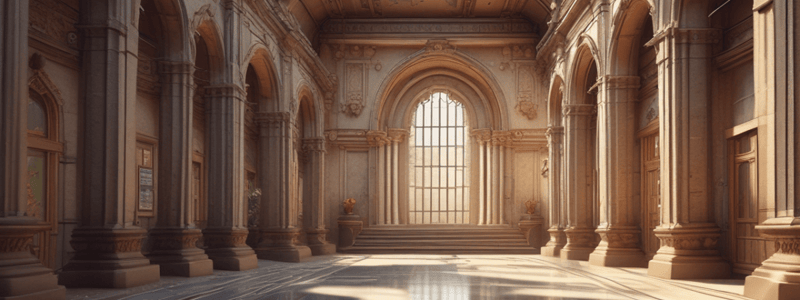Podcast
Questions and Answers
Which architectural movement rejected historical precedents and embraced new materials, forms, and functions?
Which architectural movement rejected historical precedents and embraced new materials, forms, and functions?
- Renaissance Architecture
- Baroque Architecture
- Gothic Architecture
- Modernist Architecture (correct)
Which architectural movement is characterized by pointed arches, ribbed vaults, and flying buttresses?
Which architectural movement is characterized by pointed arches, ribbed vaults, and flying buttresses?
- Renaissance Architecture
- Gothic Architecture (correct)
- Baroque Architecture
- Modernist Architecture
Which architectural movement emphasized symmetry, proportion, and geometry, marking a return to classical principles?
Which architectural movement emphasized symmetry, proportion, and geometry, marking a return to classical principles?
- Gothic Architecture
- Baroque Architecture
- Renaissance Architecture (correct)
- Modernist Architecture
During which centuries did the Baroque Architecture movement flourish?
During which centuries did the Baroque Architecture movement flourish?
Which architectural style is known for its grandeur, ornate decoration, and dramatic spaces?
Which architectural style is known for its grandeur, ornate decoration, and dramatic spaces?
What key feature characterizes Gothic Architecture?
What key feature characterizes Gothic Architecture?
Which architectural movement is known for its rejection of historical precedents?
Which architectural movement is known for its rejection of historical precedents?
What architectural style is characterized by raw, unadorned concrete?
What architectural style is characterized by raw, unadorned concrete?
Which architectural style aimed to emulate ancient Greek and Roman designs?
Which architectural style aimed to emulate ancient Greek and Roman designs?
In which century was Gothic Revival Architecture particularly popular?
In which century was Gothic Revival Architecture particularly popular?
Which architectural style is known for its ornate and geometric designs popular in the 1920s and 1930s?
Which architectural style is known for its ornate and geometric designs popular in the 1920s and 1930s?
What architectural movement reacted against modernist austerity with playful and eclectic elements?
What architectural movement reacted against modernist austerity with playful and eclectic elements?
Which historical style is characterized by rounded arches, thick walls, and decorative arcading?
Which historical style is characterized by rounded arches, thick walls, and decorative arcading?
What key feature differentiates Classical Architecture from other styles?
What key feature differentiates Classical Architecture from other styles?
Which architectural style focused on replicating medieval Gothic designs?
Which architectural style focused on replicating medieval Gothic designs?
When did Art Deco become particularly popular?
When did Art Deco become particularly popular?
What term describes the study of architectural concepts and ideas, as well as the principles behind the design and construction of buildings?
What term describes the study of architectural concepts and ideas, as well as the principles behind the design and construction of buildings?
Why is architecture often referred to as 'quasi-autonomous'?
Why is architecture often referred to as 'quasi-autonomous'?
Which publication is mentioned as a significant milestone in the study of architecture theory?
Which publication is mentioned as a significant milestone in the study of architecture theory?
In architecture, what suffix is often added to signify different approaches, like modernism and postmodernism?
In architecture, what suffix is often added to signify different approaches, like modernism and postmodernism?
Which field is NOT mentioned as part of the perspectives encompassed within architecture theory?
Which field is NOT mentioned as part of the perspectives encompassed within architecture theory?
What distinguished the study of architecture in the early 1960s from previous approaches?
What distinguished the study of architecture in the early 1960s from previous approaches?
Which term describes the idea that architecture has concepts unique to its field and is not entirely determined by other academic disciplines?
Which term describes the idea that architecture has concepts unique to its field and is not entirely determined by other academic disciplines?
What is the focus of historical architectural theory courses?
What is the focus of historical architectural theory courses?
In urbanism themes and case studies, what aspect of cities do courses typically explore?
In urbanism themes and case studies, what aspect of cities do courses typically explore?
What is a key objective of historical architectural theory courses?
What is a key objective of historical architectural theory courses?
What distinguishes urbanism themes and case studies in architecture education?
What distinguishes urbanism themes and case studies in architecture education?
Which concept is often a central theme in urbanism courses?
Which concept is often a central theme in urbanism courses?
What does historical architectural theory aim to provide students with?
What does historical architectural theory aim to provide students with?
Which aspect of architecture do urbanism courses primarily analyze?
Which aspect of architecture do urbanism courses primarily analyze?
What characterizes the study of urbanism themes in relation to architecture?
What characterizes the study of urbanism themes in relation to architecture?
What is a key aspect explored in architecture theory seminars?
What is a key aspect explored in architecture theory seminars?
How can architecture theory be used as a tool for criticism?
How can architecture theory be used as a tool for criticism?
What is one of the areas architectural theory explores regarding language?
What is one of the areas architectural theory explores regarding language?
What does the study of ecological ethos in art and architecture focus on?
What does the study of ecological ethos in art and architecture focus on?
Which aspect of architecture has gained significant interest regarding society shaping and social life fostering?
Which aspect of architecture has gained significant interest regarding society shaping and social life fostering?
What is the focus of phenomenological studies in architecture?
What is the focus of phenomenological studies in architecture?
In summary, architectural theory encompasses a broad range of topics except:
In summary, architectural theory encompasses a broad range of topics except:
Which architectural aspect serves as a tool for criticism by acting as propaganda or justification?
Which architectural aspect serves as a tool for criticism by acting as propaganda or justification?
'Ecological ethos' in art and architecture has recently emerged as significant due to its focus on:
'Ecological ethos' in art and architecture has recently emerged as significant due to its focus on:
Study Notes
Architecture Theory: Understanding Architectural Movements and Historical Styles
Architecture theory is a critical aspect of the field of architecture, encompassing the study and analysis of architectural movements, historical styles, and the development of architectural design. In this article, we will explore these topics in detail, providing a comprehensive understanding of the key concepts in architecture theory.
Architectural Movements
Architectural movements refer to distinct periods or styles in the history of architecture. These movements are shaped by various factors, including societal changes, technological advancements, and cultural influences. Some notable architectural movements include:
- Gothic Architecture (12th-16th centuries): Characterized by pointed arches, ribbed vaults, and flying buttresses, this style is known for its verticality and lightness.
- Renaissance Architecture (14th-17th centuries): This movement marked a return to classical principles, emphasizing symmetry, proportion, and geometry.
- Baroque Architecture (17th-18th centuries): Known for its grandeur and theatricality, Baroque architecture often featured ornate decoration and dramatic spaces.
- Modernist Architecture (20th century): This movement rejected historical precedents, embracing new materials, forms, and functions.
- Postmodern Architecture (late 20th century): Postmodern architecture reacted against modernist austerity, incorporating playful and eclectic elements.
Historical Styles
Historical styles refer to specific design trends or motifs that have emerged throughout history. Some common historical styles include:
- Classical Architecture: This style is inspired by ancient Greek and Roman architecture, characterized by grandeur, symmetry, and use of column.
- Romanesque Architecture: Often found in churches and castles, this style features rounded arches, thick walls, and decorative arcading.
- Gothic Revival Architecture: Popular in the 19th century, this style sought to replicate the appearance of medieval Gothic architecture.
- Art Deco Architecture: Known for its ornate and geometric designs, Art Deco was popular in the 1920s and 1930s.
- Brutalist Architecture: Characterized by raw, unadorned concrete, this style emerged in the 1950s and 1960s.
Understanding the historical styles and architectural movements is essential for architects, designers, and students of architecture to appreciate the evolution of architectural design and to develop a deep understanding of the context in which they work. By examining these styles and movements, we can gain insights into the motivations and ideas that have shaped the built environment throughout history.
Studying That Suits You
Use AI to generate personalized quizzes and flashcards to suit your learning preferences.
Description
Explore architectural movements such as Gothic, Renaissance, Baroque, Modernist, and Postmodern, along with historical styles like Classical, Romanesque, Gothic Revival, Art Deco, and Brutalist. Learn about the key characteristics and influences of each movement and style to deepen your understanding of architectural theory.




